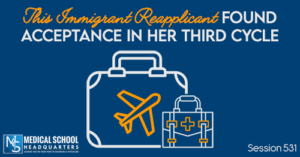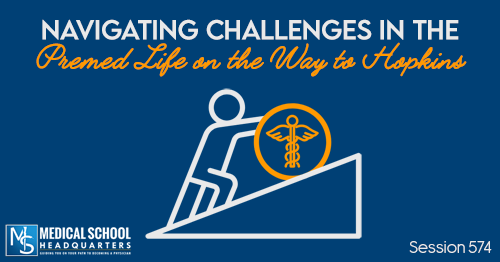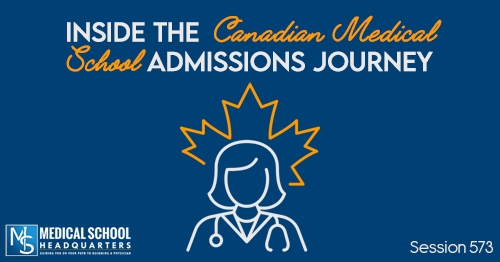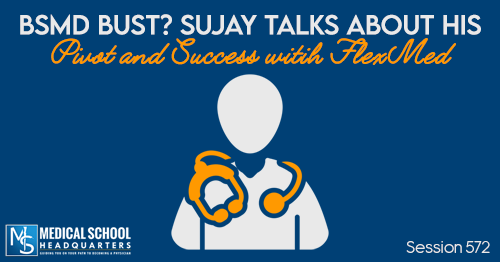Apple Podcasts | Google Podcasts
Session 531
It took Natalie three cycles to get into medical school, but with significant changes to her approach, she was accepted! Natalie is an immigrant who has applied to medical school three times. She took one extra year to get through the process and now she is on her way to medical school.
For more podcast resources to help you with your medical school journey and beyond, check out Meded Media.
Listen to this podcast episode with the player above, or keep reading for the highlights and takeaway points.
[02:34] The MCAT Minute
The MCAT minute is brought to you by Blueprint MCAT.
Finding success with your MCAT prep is through proper planning. That is why the free account at Blueprint MCAT helps so much because you get an amazing study planner tool.
The technology built into the study planner tool takes the days that you have available, the time that you have to prep and look forward to when you want to take the MCAT. It tells you exactly what you should be doing each and every step of the way.
When life gets in the way and you miss a day because you’re sick or you have something else come up, you just click, drag and drop those planned activities to another day so that you can stay on track with your MCAT prep.
Go over to blueprintmcat.com to get free access to that amazing study planner tool.
[03:56] The Dream to Become a Physician
The idea to become a physician first came when she was around 10 or 11 years old. Natalie was born with a congenital heart disease and was a pediatric cardiology patient. As a child, she had frequent visits to a cardiologist.
The EKGs were a part of the routine checkup. She remembered every single time she was getting EKG, it was very cold. It’s Russia and it’s winter. She would lay there naked with all the electrodes attached to her. She was shivering, and it was miserable.
At some point, they came to an appointment and her doctor was out of office. There was another doctor visiting. What the doctor did was put some pre-warmed electrodes on her and she gave her a little cloth to cover herself. That was a small thing but for Natalie, it made a big impact on her. That was her first thought about wanting to become a doctor.
“For me, thinking back… I guess doctors can actually care about you.” Click To Tweet[06:14] Choosing a Career Path
In Russia, you have to decide early what career path you are going to choose. Natalie graduated high school at 16. When it was time for her to choose her career path, it was a couple of years before graduation when she was around 14. It was mostly the decision of her parents.
Her mom and dad said she was not good at chemistry. She knew she was good at chemistry but they say she is not going to get into medical school for free. There were different routes she could go and there was government assistance. Her parents said she will not be able to do that. So she went to do journalism and made it her path because that was also one of her hobbies.
Path as a Journalist
Natalie graduated and worked for a couple of years as a journalist. But she said there was not a lot of money in the field. And considering the country she was coming from, it was not safe for her to say everything that she wanted to say. She had a lot of reasons why she decided not to be a journalist.
She worked for a couple of years mostly as a sports journalist. She was also very interested in things like the journalism of hotspots and war zones. Her mom was absolutely against it and told her she was not going to do that.
Migrating to the U.S.
Natalie came to the U.S. in 2016. She says she migrated for love. Her husband now is an American who does not speak any other language except English. She did not want to go to the U.S. at that time but they did not have a lot of choice.
[08:49] Revisiting the Idea of Becoming a Doctor
Natalie revisited the idea shortly before immigration. She met her husband in 2015. While they were talking about their future, how they see themselves, and what they want to do, that was the time she told him about her initial idea to be a doctor.
He encouraged her that she can still be a doctor. She was 26 years old at that time and to her, it sounded very late, and thought she could not do it. Her husband insisted that yes she can. He and her husband are each other’s supporters. It also helps that he is in a different field of work.
Settling in the U.S. and Finding a Job
When she finally got her U.S. documents and her green card, she started looking for jobs. When she started applying for jobs with her educational background from a different country, she could not find anything. It was just silence on the other end.
Her husband is in the military so Natalie talked to a military career advisor. They asked her if she wanted to go back to school and do the same thing that she went to school for in her home country. She would not go back to school for something she just spent five years of her life on. To her, that makes no sense.
“It is time to make this leap of faith and do what I was hoping to do.”Click To Tweet[10:05] Transition as an Immigrant
Natalie has been speaking English since she was a child. That was not really a problem for her and she never had a language barrier. However, she has not touched sciences since high school and she graduated high school in 2005. For her, it was basically learning everything she knew back then and it was a little adjustment for her. But overall, she was always a good student.
She did not take a lot of classes right away. During her first semester, she only took general biology and general chemistry. She managed to get A’s in both of them which gave her a big boost of confidence that she can actually do it.
There was a little bit of adjustment with her study habits and working with other people in small study groups but she made it work.
“I brought something to the table for my peers and they gave something back to me and that really helped.”Click To Tweet[12:24] Journey Into Medical School
The path to medical school was a trial and error for Natalie. She did not get accepted until she was in her third application cycle.
When she moved to the U.S. she did not have a lot to do. She was buried in her computer doing research and trying to figure out what she needed to do.
She had a good premed advisor who helped her create the postbac schedule that worked for her. Trial and error worked for her and that was a big part of it.
“It's just meeting with other people and seeing what works for them.” Click To TweetThe First and Second Application Cycles
She did not get any interviews in her first and second application cycles. She thinks it was her MCAT that was the biggest downside. She took the MCAT four times. During the first year, she took it twice. The first score she got was 500. When she retook it, it was a 495.
Her GPA was always a good thing and the only thing that never had a problem. Everything that needs to be done, she had it done, check mark wise.
Writing and Telling Her Story
The other thing was how she was telling her story. She was hoping that her persona was enough to charm her way to getting acceptance. The whole idea that she came as an adult by herself and did all the things she did and was doing well in school would make the school love her and take her. Apparently, that was not the case.
Aside from the MCAT being the biggest downside, it was also her writing. Although she was a journalist, it was not about what she wrote but how she wrote it.
Getting Feedback from Advisors and Professors
Her advisor has retired from school so she was not able to get any feedback from her. She tried to make connections and get feedback from professors and from other students that were more successful than her. She knew that the MCAT was the biggest thing that she needed to work on. It was something she needed to tackle with better preparation and a better mental health approach.
Taking and Retaking the MCAT
In the first cycle of taking and retaking the MCAT, her scores came back as 500 and 495. She retook it for the second cycle and got a 495 even if she was averaging 510 on the practice exams. She admits that it hurt her and she was blaming it on what happened in 2022 since it was during the COVID cycle.
[17:14] Taking a Detour with a Master’s Degree
Natalie came to a point where she thought about taking a detour and doing a master’s degree. She did not have a degree in the U.S: Her first degree is in journalism and she was taking the premed classes through DIY postbac. At this point, her options were to take all the hard classes. She loves organic chemistry, took advanced organic chemistry, and did really well.
She could have transitioned by transferring the credits and getting a bachelor’s degree at her home university. She just needs to take the easy, general education classes but there was no challenge to that. She went ahead and got a master’s degree in biochemistry and molecular biology.
Challenges with the Master’s Degree
For Natalie, that master’s degree in her school was challenging. They had classes with Ph.D. students. It was very intensive and research-heavy. She did not have time to worry about med school preparation although it was in the back of my mind.
“I knew that's my ultimate goal but I knew I had to put it aside for a second to focus on my studies in my master's degree.”Click To TweetThat was the reason she skipped the third cycle because she knew she won’t be able to graduate with all the hard stuff that was going on and study for MCAT at the same time.
Doing the master’s degree achieves two things in one. It was a break and it was a way of proving something to the med schools. For Natalie, it was a good thing to do.
Credit Requirements
Natalie had 77 credits from her international degree in Journalism. Most of the schools require 60 credit hours. Some schools require 90 credit hours. She went to the website of each school she was applying to and read verbatim what their requirements are.
Med Schools’ Specific Requirements
Some schools are very precise and they want to have a bachelor’s degree from the U.S. Graduate Degree from the U.S. does not count.
Even if you have a Ph.D. from Harvard, the school will not take you unless you have a bachelor’s degree from some college in the U.S. It was something she learned and paid attention to.
[21:39] Fourth MCAT Prep
In preparation for her fourth MCAT, she took the Princeton review preparation course. It was something she enjoyed. Their approach to the cue links exams is a little different than the official AAMC but she did get a lot of strategy advice which helped her.
It was Natalie’s fourth time taking it and her fourth year of trying to get into med school. At some point, you need to know when to stop. She was thinking that it would be her last shot.
“The biggest thing that I have done for myself to change my approach was how I paid a lot of attention to my mental health.” Click To TweetSeeking Mental Health Therapy
For the first time in her life, she actually did mental health therapy. Sharing what her therapist told her, it is doing things that make you feel better about yourself.
There are little mental health things that work for each person. If you want to go to bed, instead of scrolling through Tick Tock for two hours before you finally pass out, you can read a book instead or do some skincare and light up a candle.
“Each one of us has different things that we know about ourselves that make us feel better.” Click To TweetPrioritizing these things and prioritizing mental health has definitely helped her. Natalie approached her fourth MCAT prep with a better mindset. Her MCAT score came back and she got a 510. It was lower than what she was hoping but she was happy because she knew it was good enough.
[24:24] Third and Final Application Cycle
As she was approaching her third cycle application, Natalie now has a solid master’s degree and a better MCAT score. She also completely rewrote all her essays for the primary application.
Although Natalie loved the original version of her personal statement, she didn’t think it answered the question of why she wanted to be a doctor.
She says that it was more of telling how great of a doctor she is going to be, which is a common problem among a lot of students. She included some stories from her childhood and incorporated the advice she got from Dr. Ryan Gray about finding her seed and how she watered it.
The general rewriting helped. She also rewrote the activities sections. Instead of just saying what she did in bullet points which a lot of students do, she wrote a little story for each one of them.
[25:20] Support System Throughout the Process
Her husband has always been her biggest supporter. He was supporting Natalie throughout the entire process. At some point, he was very angry at the whole system and most of their conversations consisted of him ranting about how much he hates the process and the institution.
Natalie understands where it’s coming from because by now her husband already knows a lot about the process which he wishes he doesn’t. She tells him that this is just the beginning because she just got into med school.
[27:00] First Interview Invite
Her first interview invite was from her state school. It was early July and it was so fast, she could not believe what was happening. She was in the car with her husband when she received the invite.
They asked her if she was interested in one of the scholarly concentration programs. So it was not an interview invite per se but more of a question of whether she was interested in this program and if she was, they are going to send her an interview invite.
She said yes, she was very interested because that was also the concentration program of her choice. She responded to them right away and they also scheduled the interview with her pretty fast.
Traveling During the Interviews
One thing she and her husband love to do is travel a lot. She was in Portugal when she did her med school interviews.
She made sure she prepared everything. She brought her suit and all her official clothes with her. She made sure nobody was in her room and nobody was bothering her so they didn’t even ask about it. She had a very nice conversation during those two interviews. Both of them were very laid back and were very nice. There were no MMIs. Both the interviews were one-on-one or two-on-one.
[28:35] The First Acceptance
Natalie has two acceptances. She got them through a letter in the snail mail. Her experience with the first acceptance was a very emotional moment. She was interviewed in August and the acceptance came in February. It was a long wait and at some point, she started to lose hope but told herself it is what it is and it was fine.
She was no longer expecting anything and was just casually checking her mailbox when she saw that big envelope. Her hands were shaking and she was running inside, screaming her husband’s name. She started crying while her dog was barking and jumping. It was pure chaos but it was a very emotional moment for her and her husband.
[30:14] Choosing Schools
With her two acceptances, Natalie is still trying to figure out which one she would go to. One is her state school. The other one is Tulane University in New Orleans. She has never been to New Orleans and she is very excited. She admits she loves both schools and both of them have their pros and cons.
Tuition would be one of the things to consider since it’s literally twice the difference between both schools. But she is also thinking of doing the HPSP so it would not matter as much. HPSP would definitely help pay for the costs. She is already a U.S. citizen so she is eligible to do HPSP.
[31:53] Final Words of Wisdom
Have a good support system. Make sure that you have a good support system. If you don’t have one, it’s fine. Just find something that will help you keep going. Have a big, heavy answer to the big question: “Why?” Know why you want to do it. At the end of the day, that’s all going to be worth it. You are going to be somebody’s doctor.












